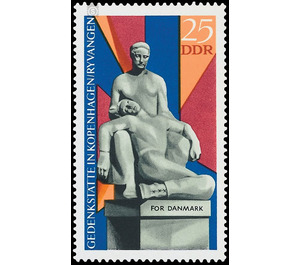International memorials - Germany / German Democratic Republic 1969 - 25 Pfennig
Theme: Architecture
| Country | Germany / German Democratic Republic |
| Issue Date | 1969 |
| Face Value | 25.00 |
| Color | multi-colored |
| Perforation | K 13:13 1/2 |
| Printing Type | offset |
| Stamp Type | Postage stamp |
| Item Type | Stamp |
| Chronological Issue Number | 1254 |
| Chronological Chapter | GER-DDR |
| SID | 75971 |
| In 11 Wishlists | |
Memorial in Copenhagen / Ryvangen, Dünemark The Ministry of Posts and Telecommunications of the German Democratic Republic issues a special postage stamp with a picture of the memorial in the National Memorial Copenhagen / Ryvangen in Denmark. From the first day after fascist Germany occupied Denmark on April 9, 1940, Danish patriots defended themselves. Several thousand Danish sailors made their ships of over 1 million GRT available to the Allies. Very soon illegal newspapers appeared in large editions. From 1942, the Danish resistance fighters went over to massive sabotage. They gave the fascist occupying power sensitive blows. When the fascists finally wanted to liquidate the Danish army and the fleet on August 29, 1943, the Danes sank their ships. The massive terror they met their united resistance. The resistance organizations continued the active struggle under the central leadership of the "Danish Freedom Council". Major strikes, more than 2,500 acts of sabotage, over 2,000 attacks on Denmark's railway network were only part of the activity. From England and Sweden, the resistance fighters were supplied with weapons and ammunition. In a large-scale operation, the overwhelming majority of all Jewish compatriots - about 7,000 - managed to bring them to the extermination camps in safety in front of the transport planned by the fascists. The illegal militia army numbered about 45,000 men and women, many of whom gave their lives in battle. On 4 May 1945 Denmark was free again. The Danish resistance movement played a significant role in the liberation. The memorial in Copenhagen / Ryvangen is dedicated to all fallen fighters of the resistance struggle in Denmark. It forms the central point in the large memorial grove (Danish: "Mindelunden") in Ryvongen near Copenhagen. The memorial grove was erected on the site where Danish resistance fighters were shot and buried by the German fascists. To the left and right of the monument are the tombs of 105 murdered people. 92 victims were buried in their hometowns. In the memorial grove there is a round earth crypt in which ashes of all Danes murdered in German concentration camps are found. The memorial grove is bordered by a wall on which the names of all those Danish resistance fighters are attached, which were deported to Germany, executed there and from which any trace is missing. The memorial grove was created by Prof. Kaj Gottob, architect M. A. A. and urban gardener Axel Andersen. Memorial grove and monument were inaugurated on August 29, 1950.


